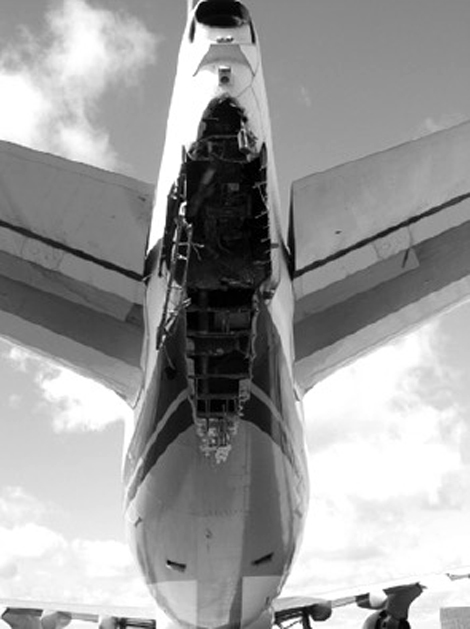Singapore Airlines flight SQ286 accident took place on takeoff from Auckland airport on March 12, 2003.
[…] the captain taxied 9V-SMT to the end of runway 23 Left to use the full runway length for take-off.The pilots had set the flap at Flap 20 and the STAB TRIM at 6.6 for the take-off.
The captain was the pilot flying and using automatic throttle applied power for take-off, having set the EPR at 1.34 for each engine.
The pilots did not notice anything untoward and everything appeared normal to them as the aeroplane accelerated down the runway.
The first officer said he called V1 as the aeroplane reached 123 kt, and rotate as it reached 130 kt.
At 132 kt the captain started pulling back the control yoke to pitch the aeroplane nose up for lift-off, and at 137 kt the pitch attitude (aeroplane body angle) began increasing.
The aeroplane average pitch rate of change was 1.3º per second to a pitch attitude of 10.8º at 150 kt and 11.8º at 151 kt with the aeroplane still on the runway.
The pitch attitude increased to 12.7º although still at 151 kt, and the aeroplane became airborne at about this speed a short time later with the pitch attitude then increasing to 12.9º.
For a normal take-off the aeroplane would have become airborne at 8.5º to 10º body angle.
Because the airspeed was too low when the aeroplane rotated, it initially remained on the ground, with its tail pitching down and striking the runway.
The tail remained in contact with the runway and scraped for about 7 seconds over a distance of about 490 m giving off white smoke. The aeroplane moved across to the right edge of the runway before becoming airborne.
The pilots said they felt a buffet during rotation (the flight data recorder (FDR) recorded an initial stick shaker indication at about this time) and the captain asked the other 2 pilots if they thought it was a tail strike, but they did not think the tail had struck the runway.
Three seconds later as the aeroplane became airborne the pilots got an Auxiliary Power Unit (APU) fire warning, followed one second later by a stick shaker warning, with the airspeed between 154 kt and 158 kt.
The captain checked the airspeed on his PFD and thought it was normal in relation to the V speeds displayed on the speed tape. The FDR showed that following the stick shaker, which activated for about 6 seconds, the aeroplane nose pitched down briefly to 8.5º body angle before increasing to 11º.
Thrust was not increased.
The first officer os Singapore Airlines flight SQ286 made a distress call advising, ”Mayday Mayday Mayday Singapore 286 we have [a] fire on [the] APU“.
The aerodrome controller acknowledged the distress call and cleared SQ286 to climb to and maintain 1000 feet and to turn left and fly a left hand circuit for runway 23. The controller advised the pilots that SQ286 had landing priority.
- The aeroplane was serviceable, correctly crewed and correctly loaded for the flight.
- The pilots were appropriately qualified and fit for the flight.
- The first officer’s incorrect recording of the gross TOW by 100 t during the before-start cockpit checks resulted in a major miscalculation of the take-off thrust and the take-off reference speeds.
- The pilots either missed or disregarded some vital cues and breached some defensive procedures, which allowed the first officer’s transcription error and his associated miscalculations to go undetected.
- Time pressure could have contributed to the pilots. non-detection of the errors.
- The checking and verification system was not robust enough to reveal the errors and prevent them from entering the FMS.
- The errors could have been detected if the operator’s procedures had required more comprehensive independent verification of essential take-off information.
- Because the aeroplane FMS did not challenge or prevent all mismatched or erroneous entries being programmed into its system there was no effective final defence against any transcription errors.
- The captain’s low type-experience level and some negative transfer from another airplane type he had recently flown might have contributed to his demonstrated lack of awareness about the performance of the aeroplane.
- Had the 2 first officers, who were experienced on type, used good airmanship and applied their knowledge the errors could have been detected.
- During take-off the captain rotated the aeroplane at too slow a speed for its weight and it failed to become airborne as intended, instead remaining on the runway and striking its tail.
- Because the captain did not respond correctly to an impending stall condition as the airplane became airborne, and because the 2 first officers did not exercise good CRM, a loss of control could have occurred.
- The ability of the aeroplane to cope with an engine failure during and for about one minute after take-off was compromised by the excessively slow take-off safety speeds.
- The erroneously low thrust used for the take-off prevented the aeroplane from accelerating normally and degraded its take-off performance and safety margins.
Had the aeroplane moved off the runway, stalled or had an engine failure with its degraded take-off performance, a more serious accident would probably have occurred.
Download Report


0 Comments